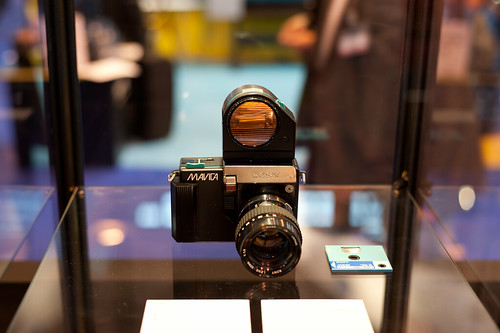Difference between revisions of "Sony Mavica (1981)"
(stub with two links, a bit of history; have requested only orig. pic on Flickr) |
(adding photo, spelling 'Mavipak' per SonyInsider source) |
||
| Line 1: | Line 1: | ||
{{stub}} | {{stub}} | ||
| + | {{Flickr_image | ||
| + | |image_source= http://www.flickr.com/photos/sonnar85/6227115320/in/pool-camerawiki | ||
| + | |image= http://farm7.staticflickr.com/6045/6227115320_1a5e92c0ed.jpg | ||
| + | |image_align= right | ||
| + | |image_text= 1981 Mavica and Mavipak disk | ||
| + | |image_by= tonic_witch | ||
| + | |image_rights= cc | ||
| + | }} | ||
In 1981, [[Sony]] startled the photographic world by creating a filmless, electronic camera for stills called the '''Mavica''' (from '''ma'''gnetic '''vi'''deo '''ca'''mera). While exhibited only in prototype form, this camera pioneered an entire "still video" market segment, later to include the [[Canon RC-701]] among others. It had an [[SLR]] design and was shown with 3 interchangeable lenses: 25mm f/2, a 50mm f/1.4 and a 16-64mm f/1.4 zoom<REF>[http://blog.sony.com/flashback-fridaysony-mavica-digital-camera-1981 "Flashback Friday: Sony MAVICA Digital Camera (1981)"] from [http://blog.sony.com/ The Sony Blog]</REF>. | In 1981, [[Sony]] startled the photographic world by creating a filmless, electronic camera for stills called the '''Mavica''' (from '''ma'''gnetic '''vi'''deo '''ca'''mera). While exhibited only in prototype form, this camera pioneered an entire "still video" market segment, later to include the [[Canon RC-701]] among others. It had an [[SLR]] design and was shown with 3 interchangeable lenses: 25mm f/2, a 50mm f/1.4 and a 16-64mm f/1.4 zoom<REF>[http://blog.sony.com/flashback-fridaysony-mavica-digital-camera-1981 "Flashback Friday: Sony MAVICA Digital Camera (1981)"] from [http://blog.sony.com/ The Sony Blog]</REF>. | ||
| − | The Mavica used a new " | + | The Mavica used a new "Mavipak" miniature floppy disk in a plastic case measuring about 2" square, able to store up to 50 images. This format was subsequently adopted as the '''video floppy''' standard and used in cameras from other companies. (Sony developed the 3.5" computer floppy disk in the same year.) |
Thirty years later, electronic cameras had become universal, but the Mavica was not a "digital" camera. While its imaging sensor had a resolution of roughly 0.28 megapixels<REF>[http://www.sonyinsider.com/2009/03/11/akio-morita-and-1981s-mavica-electronic-camera/ "Akio Morita And 1981′s Sony Mavica Electronic Camera"] in Sony's company blog [http://www.sonyinsider.com/ SonyInsider.com]</REF>, the images were saved in the form of analog scan lines, in the same manner as a television image. | Thirty years later, electronic cameras had become universal, but the Mavica was not a "digital" camera. While its imaging sensor had a resolution of roughly 0.28 megapixels<REF>[http://www.sonyinsider.com/2009/03/11/akio-morita-and-1981s-mavica-electronic-camera/ "Akio Morita And 1981′s Sony Mavica Electronic Camera"] in Sony's company blog [http://www.sonyinsider.com/ SonyInsider.com]</REF>, the images were saved in the form of analog scan lines, in the same manner as a television image. | ||
Revision as of 00:08, 19 March 2012

|
| 1981 Mavica and Mavipak disk image by tonic_witch (Image rights) |
In 1981, Sony startled the photographic world by creating a filmless, electronic camera for stills called the Mavica (from magnetic video camera). While exhibited only in prototype form, this camera pioneered an entire "still video" market segment, later to include the Canon RC-701 among others. It had an SLR design and was shown with 3 interchangeable lenses: 25mm f/2, a 50mm f/1.4 and a 16-64mm f/1.4 zoom[1].
The Mavica used a new "Mavipak" miniature floppy disk in a plastic case measuring about 2" square, able to store up to 50 images. This format was subsequently adopted as the video floppy standard and used in cameras from other companies. (Sony developed the 3.5" computer floppy disk in the same year.)
Thirty years later, electronic cameras had become universal, but the Mavica was not a "digital" camera. While its imaging sensor had a resolution of roughly 0.28 megapixels[2], the images were saved in the form of analog scan lines, in the same manner as a television image.
Notes
Links
- "Akio Morita And 1981′s Sony Mavica Electronic Camera" in Sony's company blog SonyInsider.com